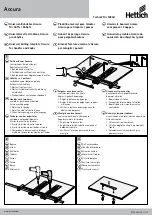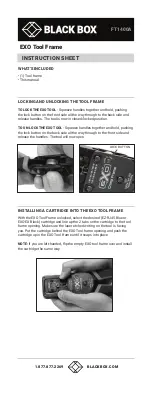
ETP SRB81-300-20-D
Safety Information
© Atlas Copco Industrial Technique AB - 9834 6192 00
7
WARNING Risk of Injury
Make sure that the correct parameter file is being used.
Wrong parameter file might cause too high torque with
bodily injury as a result.
►
Compare the maximum torque which is shown in
the controller, with the maximum torque stated in
the technical data of the tool, they should be the
same.
General Instructions
The tool may only be used together with the associated
torque reaction bar, which is adapted to the screw joint appli-
cation concerned.
WARNING Crushing Hazard
Check the rotational direction of the tool before start! A
start in an unexpected rotational direction can cause
bodily injury or property damage. Moving parts can
crush and cut.
►
Make sure that the rotational direction of the tool is
correct before starting the tool.
►
Keep hands and fingers away from moving parts.
General Service and Maintenance Safety
Always keep the controller switched off, and removable bat-
teries removed, during service in order to avoid unexpected
start-up.
Refer servicing to qualified personnel only.
Cleaning Instructions
Clean parts with a damp cloth. Only use water, no cleansers
containing solvents should be used.
Contact your Atlas Copco service technician for cleaning ad-
vice as per current recommendations and for your particular
tool.
Preventing ESD Problems
The components inside the product and controller are sensi-
tive to electrostatic discharge. To avoid future malfunction,
make sure that service and maintenance is carried out in an
ESD approved work environment. The figure below shows
an example of an appropriate service work station.
General Power Tool Safety Warnings
WARNING Read all safety warnings, instructions, il-
lustrations and specifications provided with this
product.
Failure to follow all instructions listed below may result
in electric shock, fire, property damage and/or serious
injury.
Save all warnings and instructions for future refer-
ence.
The term "power tool" in the warnings refers to your mains-
operated (corded) power tool or battery-operated (cordless)
power tool.
Work area safety
•
Keep work area clean and well lit
. Cluttered or dark
areas invite accidents.
•
Do not operate power tools in explosive atmospheres,
such as in the presence of flammable liquids, gases or
dust.
Power tools create sparks which may ignite the
dust or fumes.
•
Keep children and bystanders away while operating a
power tool.
Distractions can cause you to lose control.
Electrical safety
•
Power tool plugs must match the outlet. Never mod-
ify the plug in any way. Do not use any adapter plugs
with earthed (grounded) power tools.
Unmodified
plugs and matching outlets will reduce risk of electric
shock.
•
Avoid body contact with earthed or grounded sur-
faces, such as pipes, radiators, ranges and refrigera-
tors.
There is an increased risk of electric shock if your
body is earthed or grounded.
•
Do not expose power tools to rain or wet conditions.
Water entering a power tool will increase the risk of
electric shock.
•
Do not abuse the cord. Never use the cord for carry-
ing, pulling or unplugging the power tool. Keep cord
away from heat, oil, sharp edges or moving parts.
Damaged or entangled cords increase the risk of electric
shock.
•
When operating a power tool outdoors, use an exten-
sion cord suitable for outdoor use.
Use of a cord suit-
able for outdoor use reduces the risk of electric shock.
•
If operating a power tool in a damp location is un-
avoidable, use a residual current device (RCD) pro-
tected supply.
Use of an RCD reduces the risk of elec-
tric shock.
Personal safety
•
Stay alert, watch what you are doing and use com-
mon sense when operating a power tool. Do not use a
power tool while you are tired or under the influence
of drugs, alcohol or medication.
A moment of inatten-
tion while operating power tools may result in serious
personal injury.








































